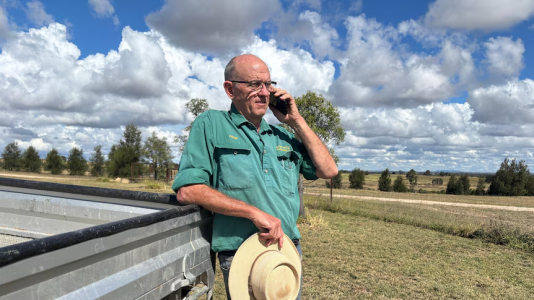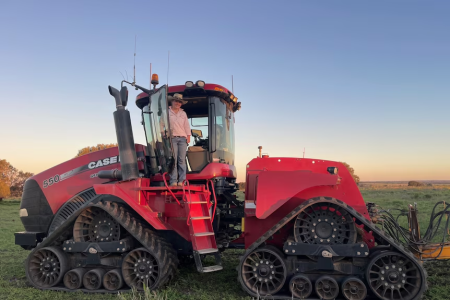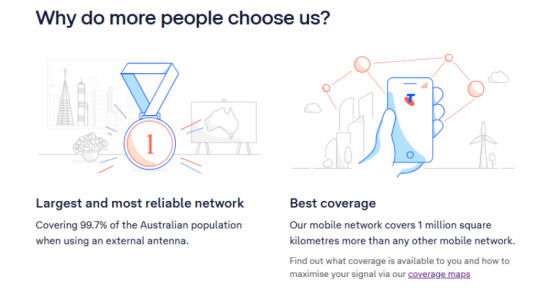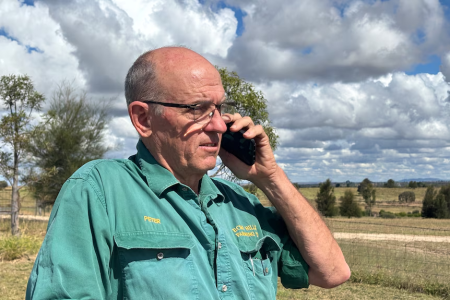Vodafone alleges rival Telstra has 'misled' customers about mobile coverage
By
ABC News
- Replies 0
Vodafone has called for the ACCC to investigate Telstra for "misleading customers" over the extent of its mobile network coverage, which it says has resulted in an unfair market advantage.
In a rare public spat between major telcos, Vodafone alleges Telstra has engaged in misleading or deceptive conduct for more than 15 years, by overstating the reach of its mobile network by as much as 40 per cent.
The TPG Telecom-owned telco wrote to the Australian Competition and Consumer Commission (ACCC) last week and urged the watchdog to launch an investigation into Telstra's conduct.
Vodafone has accused Telstra and its other mobile brand, Boost, of using "inflated" coverage claims to make unfair comparisons against other mobile operators' network coverage.
Telstra's advertised claim that it has a "mobile network coverage area of 3 million square kilometres covering 99.7 per cent of the Australian population" had, until May this year, failed to state that the figure was based on consumers using an external antenna and booster.
Antennas and other special equipment to boost coverage can cost thousands of dollars and are not generally owned by people outside of remote locations.
In comparison, Telstra's mobile coverage without using an external antenna is significantly less, around 1.9 million square kilometres, according to analysis of figures the telco has provided to the ACCC.
"That's nearly 1 million square kilometres, which is the difference between what a customer's being told they can get when they're just using their mobile phone when they're out and about, and what they could actually get," said Kieren Cooney, group executive consumer, data and analytics at Vodafone's parent company, TPG Telecom.
Vodafone has pointed to multiple examples of alleged false and misleading claims about Telstra's mobile coverage in advertising, sales and other material, including company annual reports dating back to 2009.
Website records show Telstra updated its website this month to include the clarification about antennas.
On April 16, Telstra's website stated it had the "Largest and most reliable network: we've built Australia's largest and most reliable mobile network, covering 99.7 per cent of the Australian population", with a coverage area of "3 million square kilometres" that was "1 million square kilometres more than any other network."
By May 12, Telstra's website was changed to state the telco had: "[The] Largest and most reliable network: Covering 99.7 per cent of the Australian population when using an external antenna," with a mobile network "1 million square kilometres more than any other mobile network". The website now also includes a link to Telstra's coverage maps.
“By making these changes, Telstra has effectively accepted the earlier claims were misleading, however, Vodafone does not believe the changes have addressed the misleading conduct," TPG's Mr Cooney said.
"Telstra's conduct could have misled consumers into believing they can get coverage in places that require special equipment."
Vodafone said coverage claims made on the same basis have been republished by other providers using the Telstra mobile network.
In contrast, Telstra rivals Vodafone and Optus base their network coverage claims on "outdoor coverage", a measure of the signal strength that a customer would receive using a mobile phone outside, with no special antenna or powered repeater.
In response to questions from the ABC, Telstra admitted it updated its website after being contacted by Vodafone but said any suggestion it had misled the public about the size of our network was "completely untrue.")
"No matter how you look at it, Telstra's mobile network covers more of Australia than any other.
"On any measure, Telstra's network is at least 1 million square kilometres larger than Vodafone's — that's an area more than 14 times the size of Tasmania," the spokesperson for Telstra said.
Mr Cooney said by overstating the coverage available to most Australians, Telstra and its resellers may have retained customers that would have otherwise signed up to rival telcos.
"It appears Telstra has tricked Australians into paying top dollar for coverage they simply can't get on a regular mobile phone."
Vodafone is also considering legal action to require Telstra to cease the conduct and pay compensation, however, doing so would be costly and could expose the smaller telco to counter allegations that it would be forced to defend.
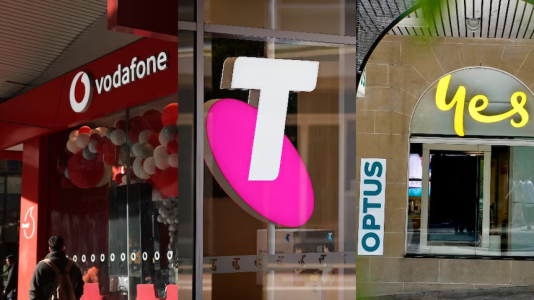
Vodafone's accused Telstra of misleading customers for more than a decade by overstating the extent of its mobile coverage network. (AAP: Con Chronis, ABC News: Michael Franchi, Dan Irvine)
'Telstra has form'
The peak advocacy group for telco consumers, the Australian Communications Consumer Action Network (ACCAN), said the allegations against Telstra were "very serious" and, along with the National Farmers Federation (NFF), has backed Vodafone's calls for the ACCC to intervene.
"If it proves to be true, it is a serious allegation that does indicate that Telstra are actually restricting competition," ACCAN CEO Carol Bennett said.
"That they are looking at increasing their own market share at the expense of other companies in the market, and in turn, for consumers, that does mean an increase in prices.
Ms Bennett said misleading and deceptive conduct had no place in any market, let alone a market for an essential service.
"We know that Telstra does have some form in deceptive and misleading conduct and that's a concern."
In 2007, the federal court ruled Telstra had misled consumers about the coverage available on its Next G mobile network.
In February this year, the federal court found that Telstra made false or misleading representations relating to the upload speed of residential broadband internet services supplied to nearly 9,000 of its Belong customers.
In August 2021, Telstra was fined $15 million for making false or misleading representations in their promotions of some 50Mbps and 100Mbps NBN plans.
"In Australia, we have limited competition and that, of course, drives up prices and when these sorts of practices occur, and it's the kind of thing that really does impact consumers and consumers deserve better," Ms Bennett said.
Market dominance
Australia's telco market is dominated by three major mobile network operators — Telstra, Optus and TPG Telecom — including through sub-brands, with a collective market share of 88 per cent, according to the ACCC's latest communications market report.
Telstra is the biggest player with a 42 per cent share of the market, followed by Optus at 28 per cent and TPG Telecom at 17 per cent. The remaining 12 per cent market share belongs to mobile virtual network operators, according to the ACCC.
Telstra's spokesperson pointed to the company's online coverage maps, including where customers can "maximise coverage".
"Using coverage maps, people can see the many towns, highways and places where we've invested to provide coverage and Vodafone hasn't. We're all for transparency and industry consistency in how we report coverage and would gladly put our maps up, side-by-side, so that Australians can see the difference."
Indeed, Telstra is the only telco available in many parts of remote and regional Australia, including where NFF telco spokesperson Peter Thompson lives.
"Telstra is the only option here, and in a lot of places," Mr Thompson said, whose grazing and grain farm of more than 7,000 hectares is located about 80 kilometres from the Queensland town of Roma.
"Most of the other providers have only put towers in the highly populated areas.
"So, in our case, Roma is the main town, where you can get Optus and Vodafone, or whoever, but once you get beyond the town limits, it's Telstra."
Mr Thompson said about 15 to 20 per cent of his property had very little or unreliable coverage.
He said Telstra's online coverage maps were unreliable.
"The maximise coverage version is false," Mr Thompson said.
"The standard map shows pretty well signal coverage if you have boosters and antennas, but the issue is the fact that just because you have signal, it doesn't mean you have signal that is usable."
Mr Thompson said Telstra's mobile network coverage maps had become even more unbelievable since the shutdown of 3G in October, because the changeover to 4G and 5G had resulted in poorer reliability in some areas.
"Frustrating is a pretty polite word for it, I've heard a lot of other people use much stronger words than that."
Like many farmers, Mr Thompson still relies on UHF radio sets and uses satellite internet.
"I wouldn't say that Telstra have been lying to us, it's just they haven't been telling the whole truth, particularly when it comes to this mapping of signal.
Calls for independent mobile network coverage map
In a statement, the ACCC confirmed it was considering Vodafone's allegations against Telstra, but at this stage, a spokesperson said it was unable to provide further comment.
The regulator added that, last year, it was forced to abandon its own analysis of mobile network coverage claims because it could not access the underlying methodologies used by the telcos to produce their coverage maps.
"Mobile operators do not have a standardised or consistent approach to the coverage maps they publish via their websites and in advertising," the spokesperson said.
"We continue to urge mobile operators to provide comparable coverage maps, which would enable consumers to compare mobile networks on a like-for-like basis.
"There is no legal requirement for mobile network operators to provide this, but the ACCC has been advocating for more transparency for consumers for some time."
There is work underway by the federal government, which has employed private consultancy firm Accenture, to map mobile coverage outside of the cities.
However, ACCAN and the NFF have some reservations about the veracity and independence of the mobile network coverage resource that the federal government has promised to produce based on the collected data.
"[We need] A coverage map tool that's independent for consumers, that enables them to ascertain whether or not they're going to get coverage in the area that they're in, or if there might be some difficulties getting access to that coverage," ACCAN's Ms Bennett said.
"At the moment, telecommunications companies put coverage maps on their own websites, and they state that these are the levels of coverage that consumers can expect.
The federal government has also promised to extend universal outdoor mobile network access by 2027 by using low-orbit satellites, which would be operated by telcos in partnership with satellite providers.
The NFF's Peter Thompson said ground-based mobile infrastructure would continue to be needed so people outside of the cities could be confident they would not find themselves in a mobile black spot.
"There are times that you can feel somewhat like a second-class citizen," he said.
"At the end of the day, all we're after is reliable, affordable communications."
Written by Rhiana Whitson, ABC News.
Last edited by a moderator:

